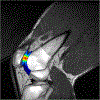Patellofemoral cartilage stresses are most sensitive to variations in vastus medialis muscle forces
- PMID: 30596523
- PMCID: PMC6468979
- DOI: 10.1080/10255842.2018.1544629
Patellofemoral cartilage stresses are most sensitive to variations in vastus medialis muscle forces
Abstract
The purpose of this study was to evaluate the effects of variations in quadriceps muscle forces on patellofemoral stress. We created subject-specific finite element models for 21 individuals with chronic patellofemoral pain and 16 pain-free control subjects. We extracted three-dimensional geometries from high resolution magnetic resonance images and registered the geometries to magnetic resonance images from an upright weight bearing squat with the knees flexed at 60°. We estimated quadriceps muscle forces corresponding to 60° knee flexion during a stair climb task from motion analysis and electromyography-driven musculoskeletal modelling. We applied the quadriceps muscle forces to our finite element models and evaluated patellofemoral cartilage stress. We quantified cartilage stress using an energy-based effective stress, a scalar quantity representing the local stress intensity in the tissue. We used probabilistic methods to evaluate the effects of variations in quadriceps muscle forces from five trials of the stair climb task for each subject. Patellofemoral effective stress was most sensitive to variations in forces in the two branches of the vastus medialis muscle. Femur cartilage effective stress was most sensitive to variations in vastus medialis forces in 29/37 (78%) subjects, and patella cartilage effective stress was most sensitive to variations in vastus medialis forces in 21/37 (57%) subjects. Femur cartilage effective stress was more sensitive to variations in vastus medialis longus forces in subjects classified as maltrackers compared to normal tracking subjects (p = 0.006). This study provides new evidence of the importance of the vastus medialis muscle in the treatment of patellofemoral pain.
Keywords: Patellofemoral pain; finite element modelling; patellofemoral stress; probabilistic modelling; quadriceps force; vastus medialis.
Conflict of interest statement
Disclosure statement: The authors have no conflict of interest to disclose related to this manuscript.
Figures






Similar articles
-
The effects of the sagittal plane malpositioning of the patella and concomitant quadriceps hypotrophy on the patellofemoral joint: a finite element analysis.Knee Surg Sports Traumatol Arthrosc. 2016 Mar;24(3):903-8. doi: 10.1007/s00167-014-3421-7. Epub 2014 Nov 15. Knee Surg Sports Traumatol Arthrosc. 2016. PMID: 25398369
-
Dose atrophy of vastus medialis obliquus and vastus lateralis exist in patients with patellofemoral pain syndrome.J Orthop Surg Res. 2021 Feb 10;16(1):128. doi: 10.1186/s13018-021-02251-6. J Orthop Surg Res. 2021. PMID: 33568152 Free PMC article.
-
Comparing two estimations of the quadriceps force distribution for use during patellofemoral simulation.J Biomech. 2006;39(5):865-72. doi: 10.1016/j.jbiomech.2005.01.030. J Biomech. 2006. PMID: 16488225
-
Computational modeling: an alternative approach for investigating patellofemoral mechanics.Sports Med Arthrosc Rev. 2007 Jun;15(2):89-94. doi: 10.1097/JSA.0b013e31804bbe4d. Sports Med Arthrosc Rev. 2007. PMID: 17505324 Review.
-
Anterior knee pain: an update of physical therapy.Knee Surg Sports Traumatol Arthrosc. 2014 Oct;22(10):2286-94. doi: 10.1007/s00167-014-3150-y. Epub 2014 Jul 6. Knee Surg Sports Traumatol Arthrosc. 2014. PMID: 24997734 Review.
Cited by
-
The non-invasive evaluation technique of patellofemoral joint stress: a systematic literature review.Front Bioeng Biotechnol. 2023 Jun 29;11:1197014. doi: 10.3389/fbioe.2023.1197014. eCollection 2023. Front Bioeng Biotechnol. 2023. PMID: 37456733 Free PMC article.
-
A Dynamic Jaw Model With a Finite-Element Temporomandibular Joint.Front Physiol. 2019 Sep 13;10:1156. doi: 10.3389/fphys.2019.01156. eCollection 2019. Front Physiol. 2019. PMID: 31607939 Free PMC article.
-
Cartilage thickness and bone shape variations as a function of sex, height, body mass, and age in young adult knees.Sci Rep. 2022 Jul 9;12(1):11707. doi: 10.1038/s41598-022-15585-w. Sci Rep. 2022. PMID: 35810204 Free PMC article.
-
A Parameter Sensitivity Analysis on Multiple Finite Element Knee Joint Models.Front Bioeng Biotechnol. 2022 May 26;10:841882. doi: 10.3389/fbioe.2022.841882. eCollection 2022. Front Bioeng Biotechnol. 2022. PMID: 35694233 Free PMC article.
-
Patellofemoral Mechanics: a Review of Pathomechanics and Research Approaches.Curr Rev Musculoskelet Med. 2020 Jun;13(3):326-337. doi: 10.1007/s12178-020-09626-y. Curr Rev Musculoskelet Med. 2020. PMID: 32394363 Free PMC article. Review.
References
-
- Amis AA, Firer P, Mountney J, Senavongse W, Thomas NP. 2003. Anatomy and biomechanics of the medial patellofemoral ligament. Knee. 10:215–220. - PubMed
-
- Beaupre GS, Orr TE, Carter DR. 1990. An approach for time-dependent bone modeling and remodeling-theoretical development. J Orthop Res. 8:651–661. - PubMed
-
- Beaupre GS, Stevens SS, Carter DR. 2000. Mechanobiology in the development, maintenance, and degeneration of articular cartilage. J Rehabil Res Dev. 37:145–151. - PubMed
-
- Benjafield AJ, Killingback A, Robertson CJ, Adds PJ. 2015. An investigation into the architecture of the vastus medialis oblique muscle in athletic and sedentary individuals: an in vivo ultrasound study. Clin Anat. 28:262–268. - PubMed
-
- Bennell K, Duncan M, Cowan S 2006. Effect of patellar taping on vasti onset timing, knee kinematics, and kinetics in asymptomatic individuals with a delayed onset of vastus medialis oblique. J Orthop Res. 24:1854–1860. - PubMed
MeSH terms
Grants and funding
LinkOut - more resources
Full Text Sources
